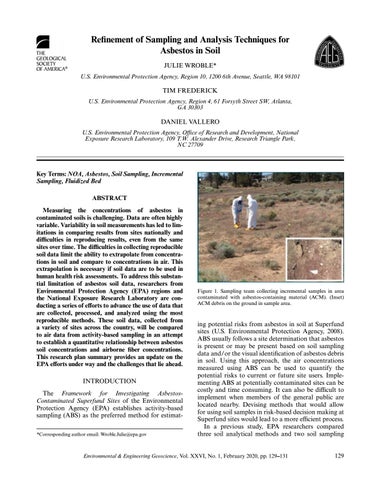Refinement of Sampling and Analysis Techniques for Asbestos in Soil JULIE WROBLE* U.S. Environmental Protection Agency, Region 10, 1200 6th Avenue, Seattle, WA 98101
TIM FREDERICK U.S. Environmental Protection Agency, Region 4, 61 Forsyth Street SW, Atlanta, GA 30303
DANIEL VALLERO U.S. Environmental Protection Agency, Office of Research and Development, National Exposure Research Laboratory, 109 T.W. Alexander Drive, Research Triangle Park, NC 27709
Key Terms: NOA, Asbestos, Soil Sampling, Incremental Sampling, Fluidized Bed ABSTRACT Measuring the concentrations of asbestos in contaminated soils is challenging. Data are often highly variable. Variability in soil measurements has led to limitations in comparing results from sites nationally and difficulties in reproducing results, even from the same sites over time. The difficulties in collecting reproducible soil data limit the ability to extrapolate from concentrations in soil and compare to concentrations in air. This extrapolation is necessary if soil data are to be used in human health risk assessments. To address this substantial limitation of asbestos soil data, researchers from Environmental Protection Agency (EPA) regions and the National Exposure Research Laboratory are conducting a series of efforts to advance the use of data that are collected, processed, and analyzed using the most reproducible methods. These soil data, collected from a variety of sites across the country, will be compared to air data from activity-based sampling in an attempt to establish a quantitative relationship between asbestos soil concentrations and airborne fiber concentrations. This research plan summary provides an update on the EPA efforts under way and the challenges that lie ahead. INTRODUCTION The Framework for Investigating AsbestosContaminated Superfund Sites of the Environmental Protection Agency (EPA) establishes activity-based sampling (ABS) as the preferred method for estimat*Corresponding author email: Wroble.Julie@epa.gov
Figure 1. Sampling team collecting incremental samples in area contaminated with asbestos-containing material (ACM). (Inset) ACM debris on the ground in sample area.
ing potential risks from asbestos in soil at Superfund sites (U.S. Environmental Protection Agency, 2008). ABS usually follows a site determination that asbestos is present or may be present based on soil sampling data and/or the visual identification of asbestos debris in soil. Using this approach, the air concentrations measured using ABS can be used to quantify the potential risks to current or future site users. Implementing ABS at potentially contaminated sites can be costly and time consuming. It can also be difficult to implement when members of the general public are located nearby. Devising methods that would allow for using soil samples in risk-based decision making at Superfund sites would lead to a more efficient process. In a previous study, EPA researchers compared three soil analytical methods and two soil sampling
Environmental & Engineering Geoscience, Vol. XXVI, No. 1, February 2020, pp. 129–131
129
